In this article, we will explore a diverse range of plants that pair harmoniously with hostas, each with unique characteristics that complement the stunning foliage of hostas.
You’ll learn how to create a dynamic, visually appealing garden that provides interest throughout the year, extending the bloom sequence and enhancing biodiversity.
Hosta companion plants pair well with hostas, complementing their aesthetic and growing habits. These companions offer contrasting colors, textures, or flowering periods to create a more vibrant and diverse garden display throughout the year.
What Makes a Good Companion Plant for Hostas
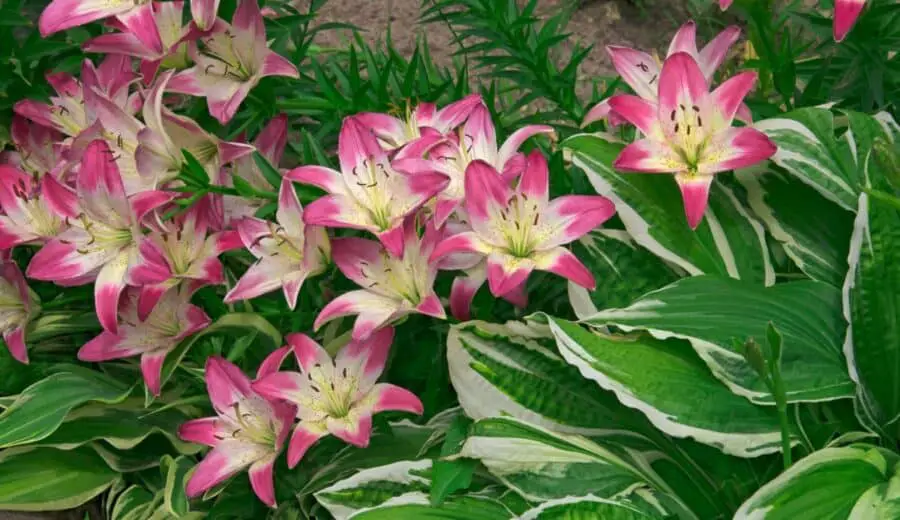
A good companion plant for hostas should ideally fulfill several criteria that complement and enhance your garden’s overall aesthetic while supporting your hostas’ health and growth.
Similar Growing Conditions: The primary factor in choosing companion plants is ensuring they share similar growing conditions. Choosing companions that enjoy the same conditions reduces competition and stress among the plants, fostering a healthier, more vibrant garden.
Contrasting Textures and Forms: Hostas are known for their broad, textured leaves. Complementary plants that contrast or highlight these characteristics can create a more visually exciting garden. Plants with fine, delicate leaves or tall, spiky forms can contrast beautifully.
Color Synchronization: Hostas’ leaves range from deep greens to bright yellows, with many variegated varieties. Companion plants with flowers or foliage contrasting or harmonizing with these colors can create a more visually cohesive garden.
Seasonal Interest: While hostas are primarily foliage plants, they produce stalks of lily-like flowers in the summer. Selecting companion plants with different blooming times can extend the garden’s interest period, ensuring there’s always something eye-catching throughout the seasons.
Pest Deterrent: Some plants are known to deter certain pests. Incorporating these into your garden may help protect your hostas from common threats like slugs and snails.
Habitat and Food Source: Companion plants that attract beneficial insects and wildlife can promote a healthier ecosystem in your garden. These insects often control pest populations and contribute to the overall biodiversity.
Structural Interest: Some companion plants can provide additional structural interest with arching sprays, towering heights, or creeping habits. Structural interest adds another layer of complexity to the garden, drawing the eye and inviting exploration.
Ultimately, the best companion plants for hostas will depend on your garden’s specific conditions and aesthetic preferences. With suitable companions, your hostas can genuinely shine, enhancing the beauty and biodiversity of your space.
Shade-Loving Companions: Ferns and Hostas
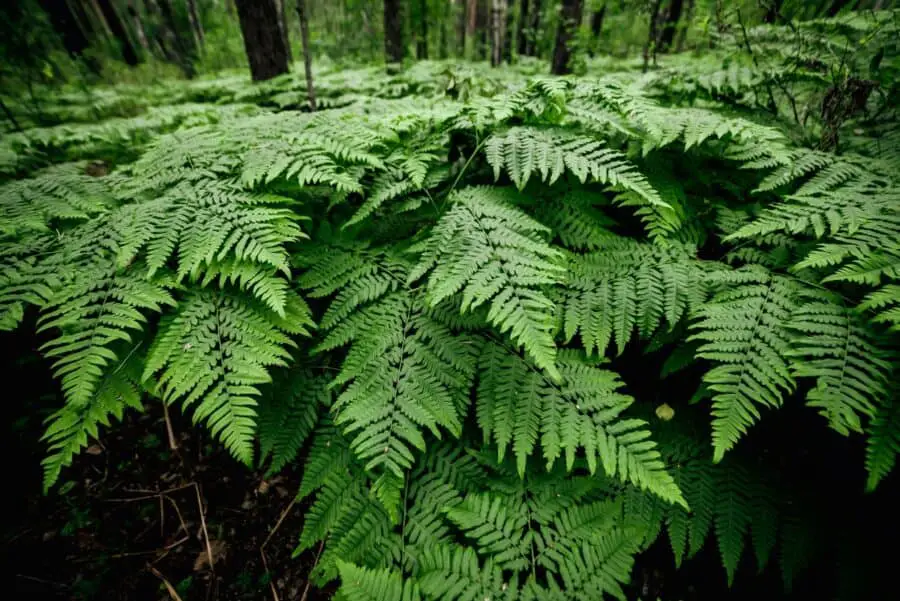
Now, let’s dive into one of my favorite pairings: ferns and hostas.
Having spent many a day navigating the shade sections of nurseries and later implementing these beauties into my designs, I can confidently tell you that this duo is an absolute gem in any shade garden.
Picture it: the bold, textured foliage of your hostas, paired with the delicate, feathery fronds of ferns. This combination creates a lush, layered effect full of texture and interest.
Plus, the similar shade requirements make them ideal partners in the garden, thriving under the canopy of tall trees or on the north side of your home.
For a detailed look at using ferns as companion plants with hostas see our article Fern and Hosta Garden: Crafting Your Shade-Loving Retreat
I remember reading The Living Landscape by Rick Darke and Doug Tallamy in my early retail nursery days.
They emphasized the concept of layering in the garden to mimic natural ecosystems. Let me tell you, pairing hostas with ferns embodies this concept to perfection.
Using Japanese Painted Ferns to Highlight Hostas
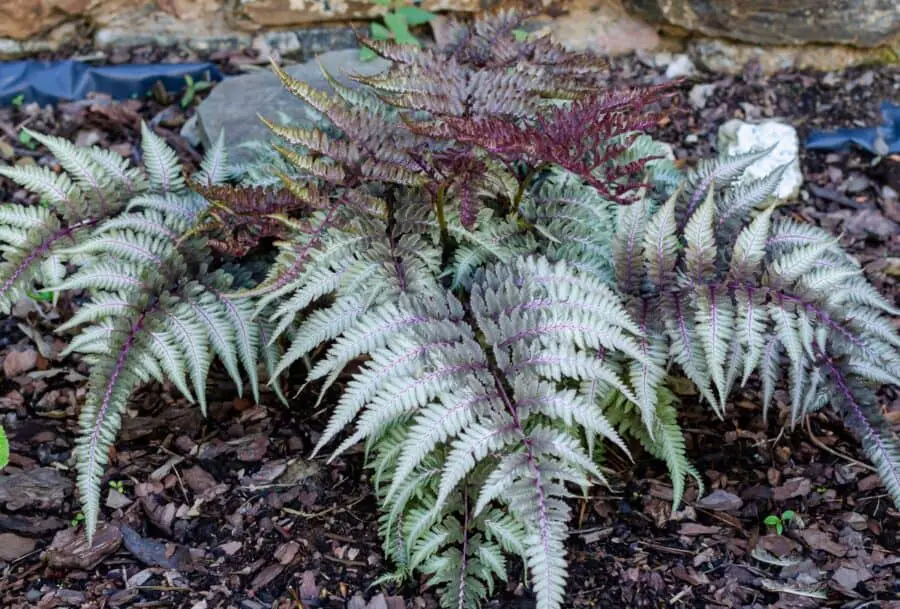
I want to mention a specific fern that has done wonders in my landscape designs: the Japanese Painted Fern.
I’ve always been a sucker for this beauty’s silvery-gray, burgundy, and blue-green fronds, and guess what? They play exceptionally well with the foliage of hostas.
The beautiful hues of the Japanese Painted Fern can both contrast and harmonize with hosta foliage, depending on which variety you choose.
For instance, if you have a blue-leafed hosta like ‘Halcyon,’ the silvery fronds of the fern will make the blue tones pop. On the other hand, a golden hosta like ‘August Moon’ will create a warm, glowing effect when paired with this fern.
So, consider incorporating some Japanese Painted Ferns into your hosta garden. Trust me, your garden (and your neighbors) will thank you. Stay tuned for more of my favorite hosta companions – because we’re just starting.
Pairing Hostas with Astilbes: Creating a Showy Display
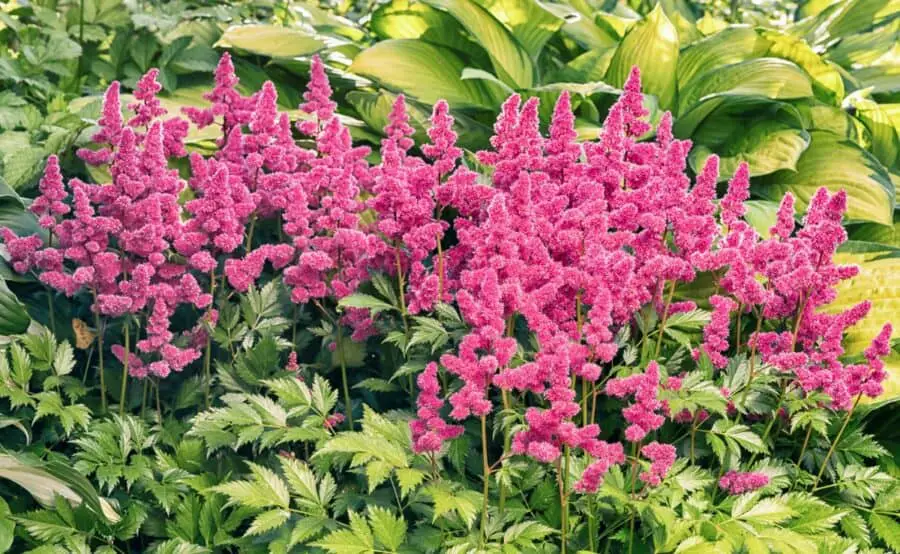
Astilbes, with their plume-like flowers and ferny foliage, create a delightful contrast to hostas’ bold, leafy form.
This pair is perfect if you’re aiming to create a multi-dimensional and textured display that’s pleasing to the eye and engages the senses. When astilbes bloom, they offer a soft, colorful counterpoint to the lush greenery of hostas.
Now, astilbes aren’t just about looks. Like hostas, they thrive in partial to full shade and prefer well-drained, moist soil.
For an in-depth look at mixing astilbes and hostas in the garden see our article Hosta and Astilbe Garden: Creating Your Perfect Shade Oasis
That’s right, and you won’t have to worry about catering to the unique needs of two different plants. These two will get along just fine, complementing the other’s needs and preferences.
So next time you’re at your local nursery or browsing an online catalog, why give astilbes a second look?
With their feathery blooms in various colors, from pure whites to rosy pinks and rich reds, astilbes can inject color into your hosta garden, creating a layered and dynamic display that will turn heads.
Adding astilbes to your hosta garden will be like the final brushstroke on your gardening masterpiece.
Heucheras: Offering a Colorful Contrast
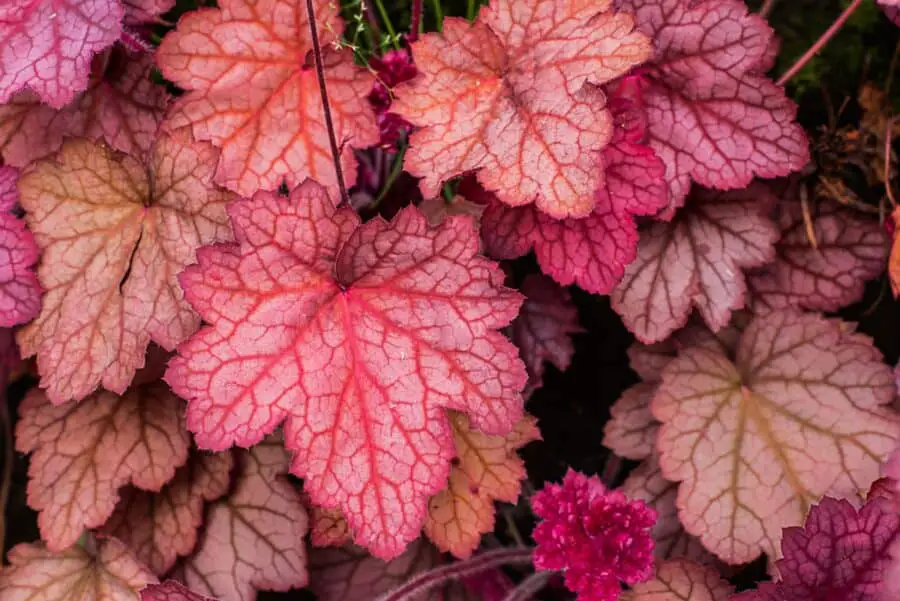
Let’s step away from the emerald world of hostas and dip our toes into a colorful palette from the lovely Heucheras. If you’re looking for a way to spice up your hosta garden with a pop of color, look no further.
These versatile perennials, or Coral Bells, are about to become your new best friend.
Heucheras come in an astonishing array of hues, from warm caramel and gold to deep burgundy and plum, of nearly every shade.
Picture this vibrant foliage nestled against your hostas’ soothing greens and blues. The contrast is, in a word, stunning.
What makes Heucheras and Hostas a dynamic duo? Beyond the spectacular color play, both plants have similar cultural needs. They prefer well-drained soil and can happily co-exist in partial and full shade conditions. It’s like they are made to be together!
To learn more about companion planting Coral Bells with Hostas check out our article Coral Bells and Hostas: Make A Great Garden Combination
I was introduced to the wonders of Heucheras through a gem of a book, Heucheras and Heucherellas: Coral Bells and Foamy Bells by Dan Heims and Grahame Ware.
The author’s deep passion for these plants is contagious, and their insights on the beautiful contrast between Heucheras and hostas are enlightening.
So, consider Heucheras if you want to add some drama to your hosta garden. They’re easy to grow, offer almost year-round interest, and, best of all, they make your hostas shine even brighter.
Hydrangeas and Hostas: An Enchanting Duo
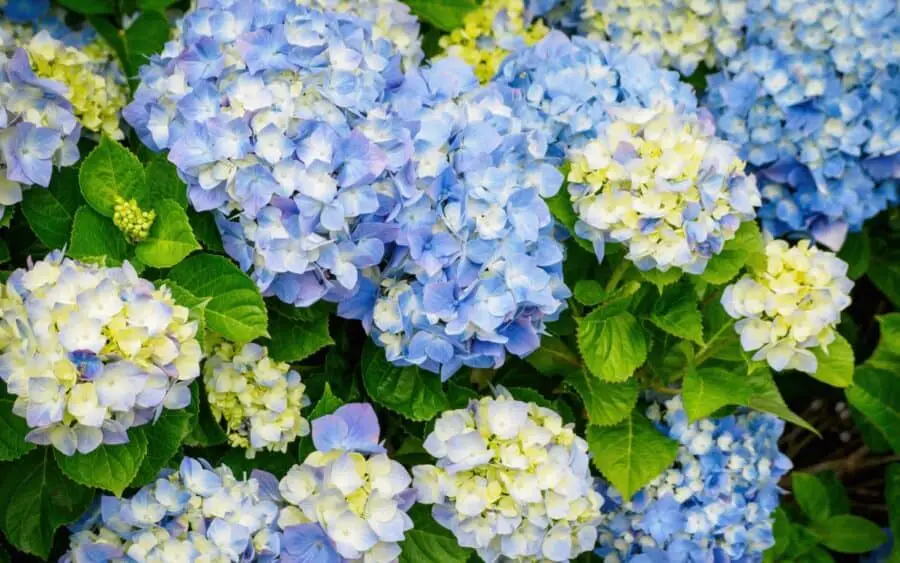
Picture the scene: Your hostas are in full summer glory, their broad leaves a perfect foil to the delicate lace caps or robust mopheads of your hydrangeas in bloom.
The shades of pink, blue, or creamy white hydrangea blossoms against the bold, textured hosta foliage create a picture that would make any garden magazine cover envious.
Remember how hydrangeas made waves in Michael Dirr’s Hydrangeas for American Gardens? He described how they offer a ‘bountiful summer presence’ that few other shrubs can match.
Now, take that presence and layer in some robust hosta foliage at the base – it’s a match made in horticultural heaven!
Hydrangeas and hostas share similar growing conditions, preferring partial shade and well-drained, fertile soil. Making them ideal companions, looking out for each other as they grow and develop.
This classic pairing offers a balance of bold and delicate, with a harmony of form and color that will make your garden the envy of the neighborhood.
Complementing Hostas with Rhododendrons

Rhododendrons are diverse, from low-growing dwarfs to tall, tree-like species. Making them versatile companions for hostas.
Smaller rhododendrons can provide a colorful, mid-level layer in your garden design. In contrast, larger ones can offer a stunning backdrop for your hosta display.
Not to mention, both rhododendrons and hostas have similar cultural needs. They love partial shade and thrive in well-drained, fertile, and slightly acidic soil. So, they’re not just good-looking together, they’re a practical pair too!
Adding rhododendrons to your hosta garden does more than boost its aesthetic appeal—it can also extend your garden’s blooming season.
With rhododendrons typically flowering in late spring and hostas following with summer blooms, you’ll have sequential color to enjoy throughout the growing season.
So, when planning your hosta garden, remember to leave some room for rhododendrons.
Their variety in size, spectacular spring blooms, and the depth they add to your garden’s design make them a worthy companion for your beloved hostas.
Hardy Geraniums: The Perfect Understudy for Hostas
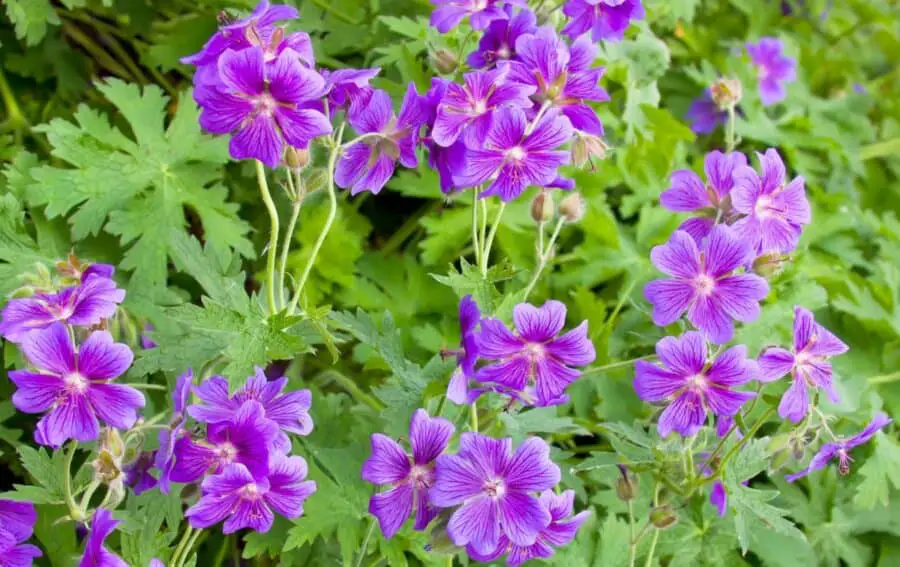
Hardy geraniums bring a delicate yet dynamic presence to the garden, creating an excellent balance with the robustness of hostas.
They offer a wide array of bloom colors, from soft pinks and purples to vivid blues, and their dissected foliage adds a touch of whimsy that contrasts beautifully with the broad leaves of hostas.
But it’s not all about looks with this pair. While your hostas steal the show in shady corners, geraniums can pick up the baton in sunnier spots, creating a seamless visual transition.
Beyond their aesthetic and cultural compatibility, the addition of hardy geraniums can help extend your garden’s bloom period.
Most hardy geraniums flower in late spring to early summer, just as your hostas begin to send up their bloom stalks.
If you want to add depth, color, and extended bloom time to your hosta garden, give hardy geraniums a chance.
They’re reliable, versatile, and incredibly charming—the perfect understudy for your beloved hostas. Together, they can transform your garden into a tapestry of textures and colors.
Achieving Textural Balance: Pulmonaria and Hostas
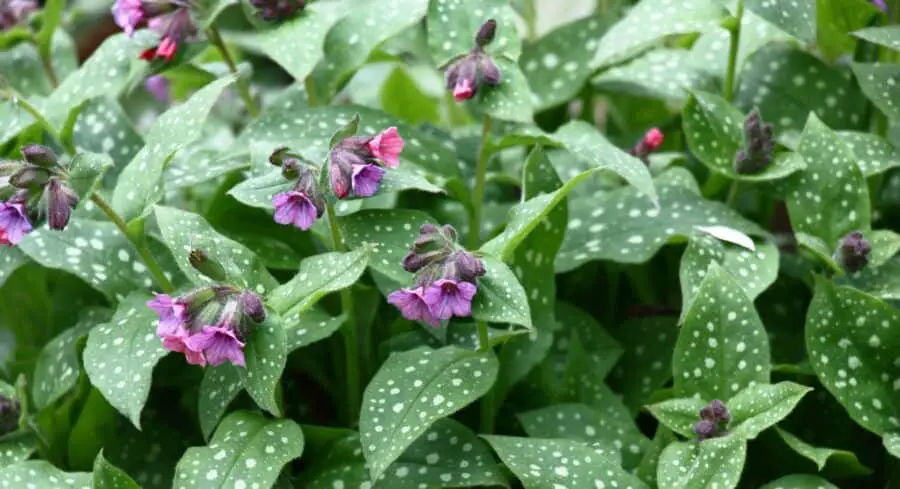
Pulmonaria, also known as lungwort, is a marvel of texture. Its leaves, often spotted or marbled, contrast with hosta foliage’s bold, solid hues.
Pulmonaria’s slim, delicate leaves and hosta’s wide, textured ones form a textural tapestry that is as compelling as beautiful.
Adding Pulmonaria to your hosta garden amplifies its textural appeal and adds a lovely splash of spring color.
Pulmonaria flowers early in the spring, with blooms in shades of blue, pink, and white that perfectly complement the emerging foliage of hostas.
Adding Structure with Hosta Companion Plants: A Look at Ligularia
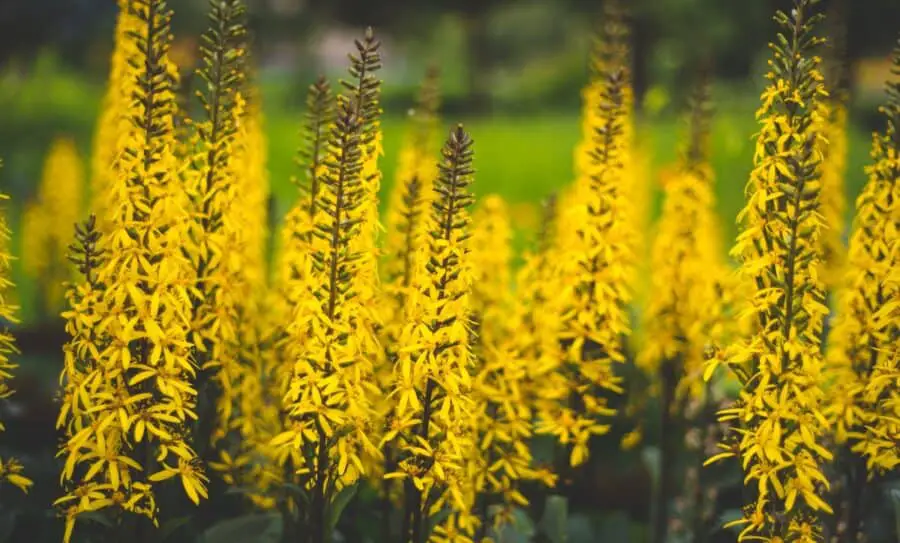
With its large, sculptural leaves and tall flower spikes, Ligularia can add a dramatic vertical element to your hosta plantings.
Their bold form and vibrant yellow or orange flowers offer an excellent counterpoint to hostas’ more horizontal growth habit and muted bloom colors.
Much like hostas, Ligularia thrives in part to full shade and requires fertile, well-drained soil. However, Ligularia prefers more moisture than hostas, so consider placing them in a part of your garden that tends to be damp.
One of the exciting things about pairing Ligularia with hostas is the extended bloom period this duo provides.
Ligularia tends to flower in late summer, just as most hosta varieties finish their bloom cycle. This means you can have a continuous wave of bloom color in your garden from spring through late summer.
Yes, Grasses: Japanese Forest Grass
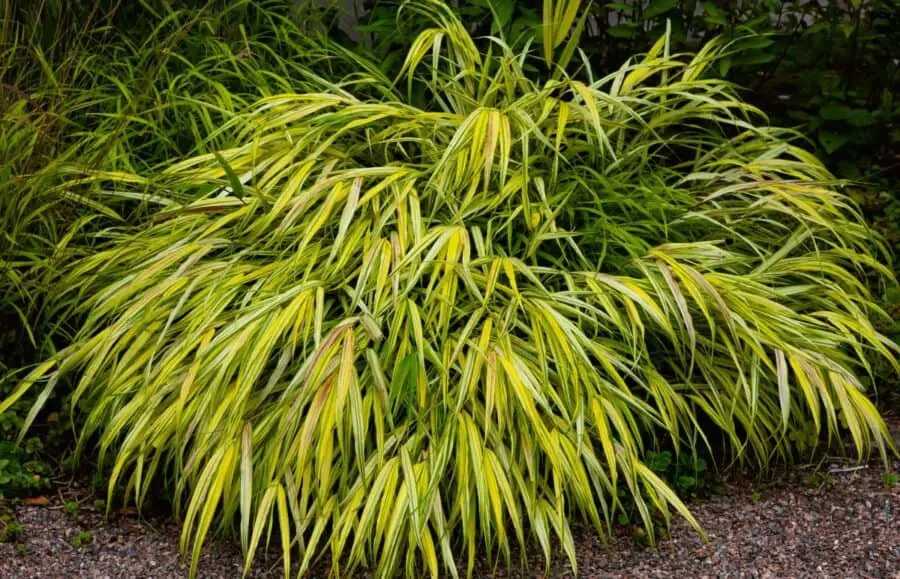
Also known as Hakonechloa macra, Japanese forest grass brings your garden a unique, flowing texture.
Its soft, arching leaves sway gracefully in the breeze, creating a dynamic contrast to the hostas’ more static, sturdy leaves.
Like hostas, Japanese forest grass prefers part to full shade and well-drained, fertile soil.
However, it can tolerate a bit more sun than hostas, making it a perfect choice to transition from the shady hosta garden to the sunnier areas of your landscape.
Regarding texture in the garden, I’ve always found inspiration in the work of Noel Kingsbury and Piet Oudolf, Designing with Plants. They emphasize the role of grasses in adding movement and seasonal interest to plantings.
One of the many beautiful aspects of Japanese forest grass is its vibrant golden color, which comes alive in the autumn.
If you want to step outside the box and experiment with your hosta companions, give Japanese forest grass a shot.
Its graceful form, contrasting texture, and autumnal color will add a fresh, lively dimension to your hosta plantings.
Season Extenders: Spring Bulbs
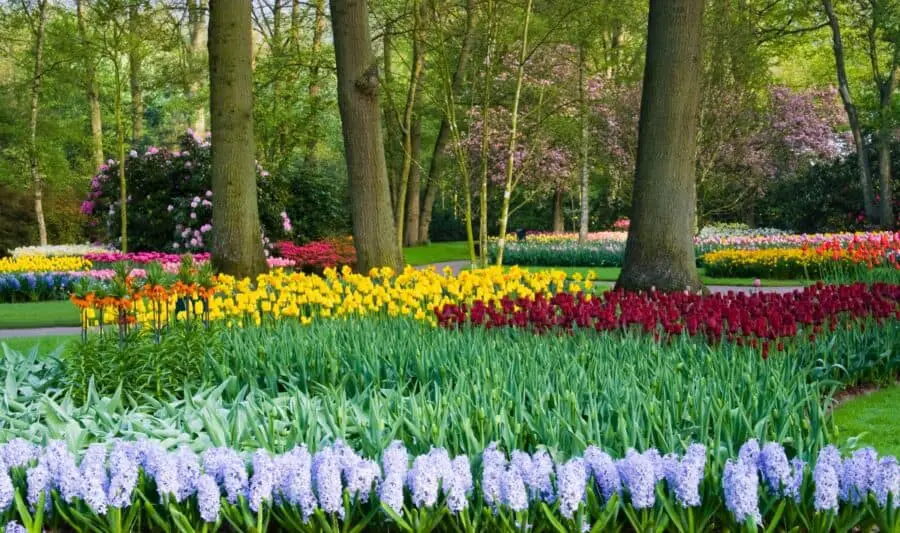
While hostas are still waking up from their winter slumber, these early bloomers can put on a spectacular show that helps extend your garden’s interest throughout the year.
Spring bulbs, like daffodils, tulips, and crocuses, burst into life early in the season, filling your garden with vibrant splashes of color.
As their foliage starts to fade, the hostas unfurl, effectively hiding the dying bulb foliage while taking over the color show.
It’s worth noting that most spring bulbs prefer well-drained soil and sunny to partially shaded locations.
However, since they grow and bloom before the canopy trees fully leaf out, they can be entirely compatible with the semi-shaded conditions that hostas prefer.
Polygonatum for Arching Sprays
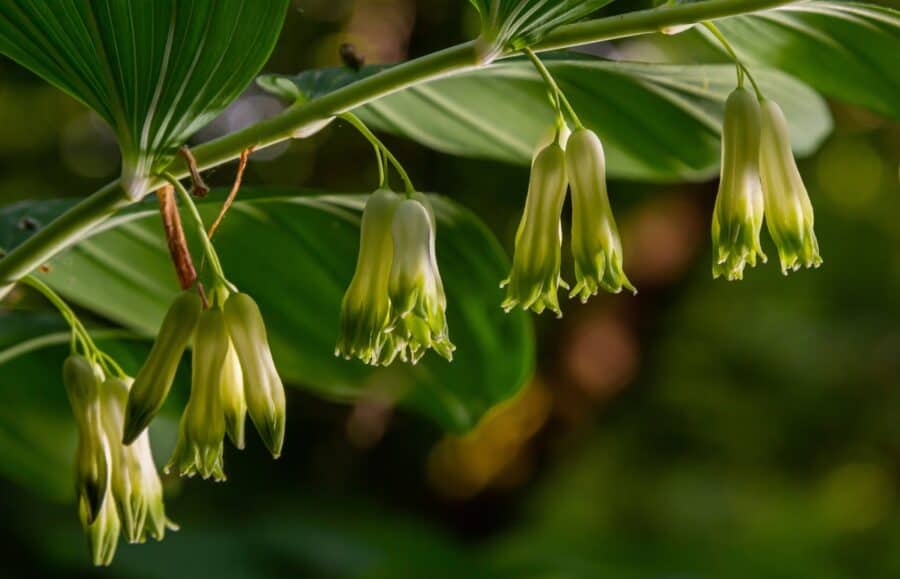
Polygonatum’s unique form and growth habit provide a striking counterpoint to the broad, sturdy leaves of hostas.
The graceful arching sprays of this woodland perennial, adorned with delicate, bell-shaped flowers, create a dramatic visual interplay with the bold textures of hostas.
Polygonatum’s flower sprays are followed by attractive, round berries that persist into the fall, providing extended seasonal interest.
So, if you want to infuse a touch of grace and charm into your hosta garden, consider adding Polygonatum.
With their arching sprays of flowers and fruits, they’ll bring a unique rhythm to your garden.
Boosting Aesthetics: Color Contrasts in Hosta Combinations
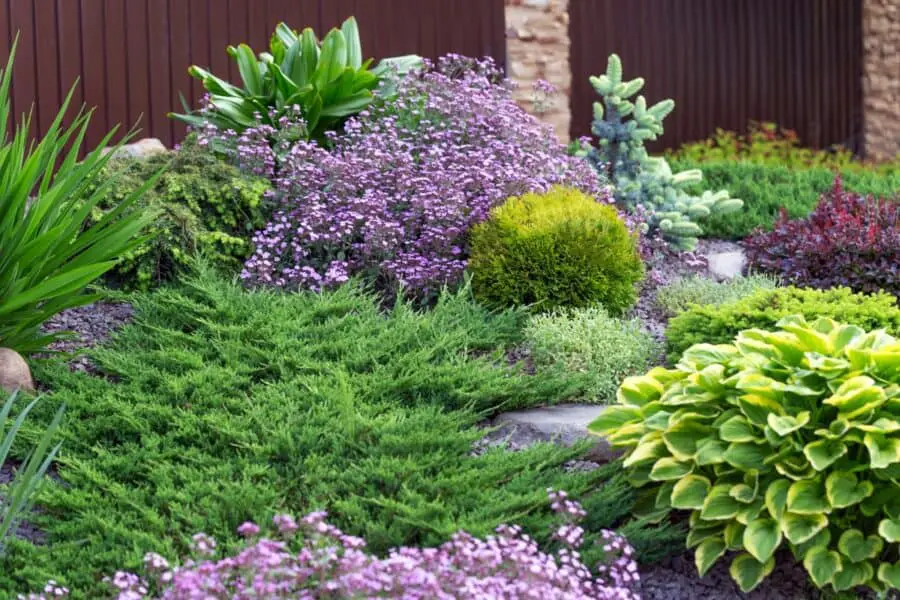
When it comes to elevating the aesthetics of your hosta garden, few strategies are as effective as playing with color contrasts.
Hostas come in various leaf colors—from vibrant greens to cool blues and even variegated forms featuring white or gold.
By pairing these with plants that have contrasting colors, you can create stunning combinations.
For instance, consider the striking contrast a blue hosta creates when paired with a plant featuring golden foliage, like a Golden Hakone grass or a chartreuse heuchera.
Creating color contrasts isn’t limited to foliage alone. You can consider the colors of flowers, stems, and even fall foliage.
For instance, the reddish-purple flowers of a companion plant like Astilbe’ Fanal’ can make a dramatic impact against the green or blue-green foliage of hostas.
Remember, the aim here is not just to create contrast but to do so in a way that brings harmony and balance to your garden design.
It’s about painting a picture pleasing to the eye, where each color enhances and celebrates the others.
So, consider playing with color contrasts if you want to give your hosta garden an aesthetic boost. It’s a fun, creative process that can result in a garden that’s not just beautiful but also uniquely yours.
Closing Thoughts: Elevating Your Garden With Hosta Companion Plants
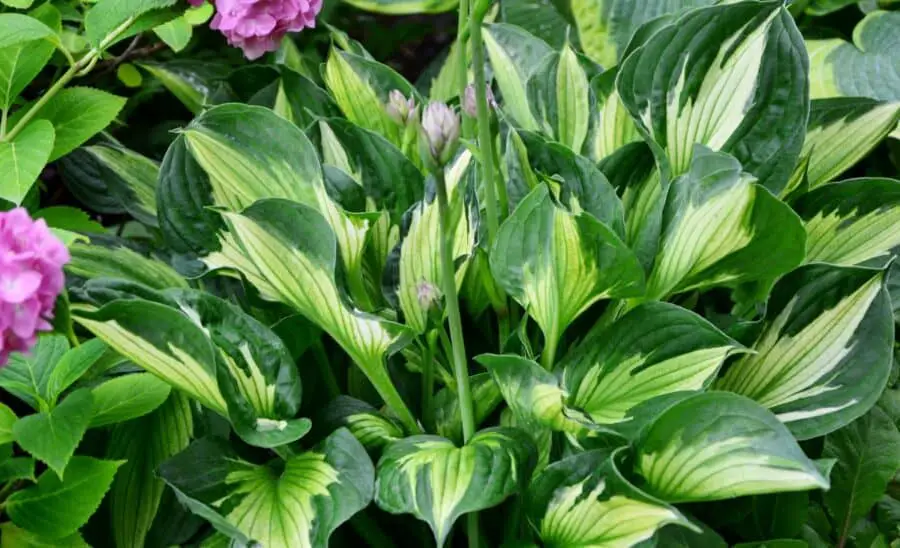
I’ve always found immense joy and satisfaction in creating plant combinations that thrive together and enhance each other’s beauty.
Hostas provide a perfect canvas for this with their lush foliage and adaptable nature.
Remember that creating a successful hosta garden is not just about picking out pretty companions. It’s about understanding each plant’s needs, growth habits, and seasonal changes.
It’s about planning for the succession of blooms and the contrasting play of colors and textures. It’s about balancing the solid and reliable presence of hostas with the unique qualities of their companions.
Much like in a well-tuned orchestra, each plant in your hosta garden has a part to play. Some might have a brief but dramatic solo in the early season, like spring bulbs.
Others, like the various hosta varieties, provide a steady rhythm throughout the year. Then there are those like the Japanese Forest Grass or the Hardy Geraniums that bring harmony that ties the entire piece together.
Above all, creating a hosta garden should be an enjoyable journey. As you experiment with different companions, don’t be afraid to make changes, try new combinations, and, most importantly, have fun.
After all, as I often like to remind my readers, gardening is as much an art as it is a science.